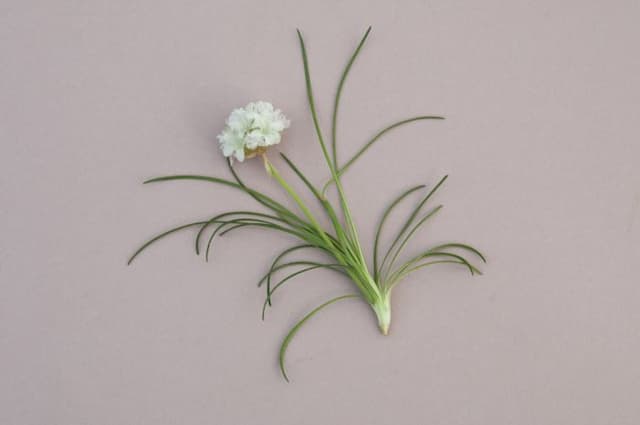White Thrift Armeria juniperifolia 'Alba'
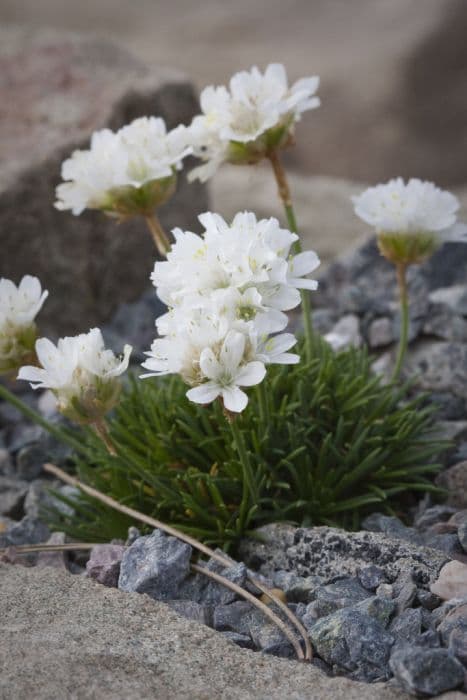
ABOUT
Armeria juniperifolia 'Alba', commonly known as white thrift, is a perennial garden plant notable for its tufted evergreen foliage and charming flowers. The leaves are needle-like, resembling those of a juniper, giving it a dense, cushion-like appearance. They are arranged in a tight, low-growing mound that serves as a backdrop for its striking blooms. The flowers of white thrift are what really catch the eye. They appear as round, ball-shaped clusters perched atop long, slender stalks that rise above the foliage. Each cluster is composed of small, individual white flowers that come together to create a soft, cotton-like effect. The overall appearance of the white thrift is quite compact and neat, with the contrast between the green foliage and white flowers being especially eye-catching. It exudes an elegant simplicity, making it a popular choice for rock gardens, borders, and as ground cover in a variety of landscaping designs. The plant is resilient, often found flourishing in coastal areas where other plants might struggle.
About this plant
 Names
NamesFamily
Common Names: White Thrift, White Cushion Thrift, White Sea Thrift, Juniper-leaved Sea Thrift. Plumbaginaceae.
Synonyms
White Thrift, White Cushion Thrift, White Sea Thrift, Juniper-leaved Sea Thrift. Family: Plumbaginaceae.
Common names
Armeria juniperifolia 'Alba'.
 Toxicity
ToxicityTo humans
The plant commonly known as Thrift (Armeria juniperifolia 'Alba') is not known to be toxic to humans. It does not typically cause any symptoms of poisoning when ingested. However, as with any plant not intended for consumption, ingesting Thrift in large amounts may lead to gastrointestinal discomfort or other non-specific symptoms.
To pets
Thrift (Armeria juniperifolia 'Alba') is also not known to be toxic to pets. It is generally considered safe, and there are no well-documented reports of poisoning in animals after ingesting this plant. Therefore, no specific symptoms of poisoning or consequences are typically expected if pets consume parts of the Thrift plant.
 Characteristics
CharacteristicsLife cycle
Perennials
Foliage type
Evergreen
Color of leaves
Green
Flower color
White
Height
6 inches (15 cm)
Spread
1 foot (30 cm)
Plant type
Herb
Hardiness zones
5
Native area
Europe
Benefits
 General Benefits
General Benefits- Ornamental Value: Adds aesthetic appeal to gardens with its white, globular flower clusters and mat-forming evergreen foliage.
- Drought Tolerance: Once established, it requires minimal water, making it suitable for xeriscaping or drought-prone areas.
- Low Maintenance: Requires little care beyond occasional pruning to maintain its compact shape.
- Cold Hardiness: Resistant to cold temperatures, making it suitable for planting in USDA hardiness zones 4 through 8.
- Soil Adaptability: Tolerates a variety of soil types, including sandy and rocky soils, as long as they have good drainage.
- Attracts Pollinators: Attracts butterflies and bees, which are beneficial for pollination in the garden.
- Deer Resistance: Tends to be deer resistant, offering an advantage in areas with high deer populations.
- Salt Tolerance: Capable of withstanding salty environments, making it ideal for coastal landscapes or roadsides where de-icing salts are used.
- Compact Size: Its small size makes it perfect for rock gardens, borders, and containers.
 Medical Properties
Medical PropertiesThis plant is not used for medical purposes.
 Air-purifying Qualities
Air-purifying QualitiesThis plant is not specifically known for air purifying qualities.
 Other Uses
Other Uses- Crafting dried flower arrangements: The globe-shaped, white flowers of Sea Pink can be used in dried arrangements to add a delicate touch to home decor.
- Education and research: Sea Pink is an example in botany classes to illustrate the adaptive characteristics of plants that thrive in rocky, coastal environments.
- Photography: With its aesthetic appeal, Sea Pink is a popular subject for photographers specialising in botanic and landscape imagery.
- Garden design: Sea Pink can be used to create a "living edge" along walkways or borders, providing a structured yet natural look.
- Miniature gardening: Being a compact plant, Sea Pink is an excellent choice for fairy gardens and miniature landscapes.
- Erosion control: The dense, mat-forming habit of Sea Pink makes it useful for stabilizing soil in sloped gardens and coastal areas.
- Event decorations: The petite and charming flowers of Sea Pink can be used as natural decor for weddings and other special events.
- Green roofing: Due to its low maintenance and ability to withstand harsh conditions, Sea Pink is suitable for planting on green roofs.
- Culinary decoration: The non-toxic flowers can be used to add a touch of elegance when plating gourmet dishes, although consumption should be done with caution and proper knowledge.
- Beach-themed crafts: The plant can be integrated into beach-themed crafts such as wreaths and centerpieces to evoke a coastal ambiance.
Interesting Facts
 Feng Shui
Feng ShuiThrift is not used in Feng Shui practice.
 Zodiac Sign Compitability
Zodiac Sign CompitabilityThrift is not used in astrology practice.
 Plant Symbolism
Plant Symbolism- Resilience: Armeria juniperifolia 'Alba', commonly known as Thrift or Sea Thrift, often symbolizes resilience because it thrives in rocky, coastal environments and can withstand harsh conditions.
- Persistence: Its ability to grow in difficult areas and bloom year after year represents persistence and the determination to overcome obstacles.
- Conservation: Thrift suggests a theme of conservation, as it is well-adapted to grow in poor soils and thus reflects the idea of making the most of limited resources.
- Longevity: The plant's perennial nature, surviving for many years, signifies longevity and endurance over time.
 Water
WaterThe common name of Armeria juniperifolia 'Alba' is White Cushion Sea Thrift, which prefers to be watered when the top inch of soil feels dry. It's important not to overwater, so checking the soil moisture level before watering is essential. Generally, this may result in watering once or twice weekly, depending on climate conditions and season. When watering, aim to provide enough water to moisten the soil throughout the root zone, which can be around 1 to 2 gallons depending on the size of the plant and the container or garden bed it is in. During the cooler months, watering frequency should be reduced as the plant's growth slows down and less water is required.
 Light
LightWhite Cushion Sea Thrift thrives best in full sun conditions where it can receive at least 6 hours of direct sunlight each day. It's tolerant of some light shade, especially in hotter climates, but the best spot for optimal growth is a location where the bright sunlight encourages strong flowering. Avoid deep shade areas as this can result in fewer blooms and a leggy plant.
 Temperature
TemperatureWhite Cushion Sea Thrift is hardy and can withstand a temperature range from about 10°F to 80°F. However, for optimal growth, it prefers a cooler climate and does well in temperatures typically ranging from 50°F to 70°F. It can survive short periods of frost but prolonged exposure to temperatures below 10°F may be detrimental to the plant.
 Pruning
PruningWhite Cushion Sea Thrift benefits from light pruning to maintain its compact shape and to encourage more vigorous blooms. Prune back the faded flowers after the initial bloom, which may encourage a second flush of flowers. Annually, cut back the entire plant by about one-third in the late winter or early spring to remove dead foliage and to promote fresh growth. This pruning helps to prevent the center of the plant from becoming woody and less attractive.
 Cleaning
CleaningAs needed
 Soil
SoilThrift prefers well-draining soil mixed with sand and peat to mirror its natural coastal habitat, with a slightly acidic to neutral pH of 5.5 to 7.0 for optimal growth.
 Repotting
RepottingThrift, also known as Sea Pink, should be repotted every 2-3 years to refresh the soil and accommodate root growth.
 Humidity & Misting
Humidity & MistingSea Pink thrives in environments with moderate humidity levels, not requiring any special humidity adjustments when grown in its preferred outdoor settings.
 Suitable locations
Suitable locationsIndoor
Provide bright light, minimal water, and well-draining soil mix.
Outdoor
Plant in full sun, well-draining soil, and water sparingly.
Hardiness zone
4-8 USDA
 Life cycle
Life cycleArmeria juniperifolia 'Alba,' commonly known as Thrift or Sea Pink, begins its life as a seed, emerging through the soil as a tiny seedling. As the root system establishes in well-drained soil, the plant develops a low-growing mat of needle-like foliage. In spring to early summer, flower stems elongate from the foliage, producing globe-shaped clusters of white flowers that attract pollinators. After flowering, seeds form and disperse, allowing the cycle to continue. Throughout its life, this perennial plant remains evergreen, though it may become dormant in colder climates during winter. With proper care, the Thrift can regenerate year after year, clumping and potentially spreading in its designated garden space.
 Propogation
PropogationPropogation time
Spring to Summer
Propogation: Armeria juniperifolia 'Alba', commonly known as thrift or sea pink, is often propagated by division, which is most successful when performed in the spring or early fall. To propagate by division, carefully dig up the clump of thrift and gently separate it into smaller clumps, ensuring that each section has a portion of the root system intact. Replant the divisions immediately into well-draining soil at the same depth they were growing previously, spacing them about 6 to 12 inches (approximately 15 to 30 centimeters) apart to allow room for growth. Water the newly planted divisions thoroughly to help establish them. Over time, these new plants will grow into full-sized clumps that can themselves be divided and propagated to create new plants.
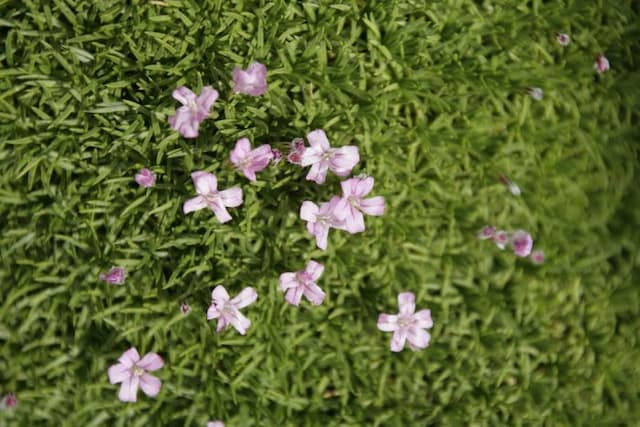
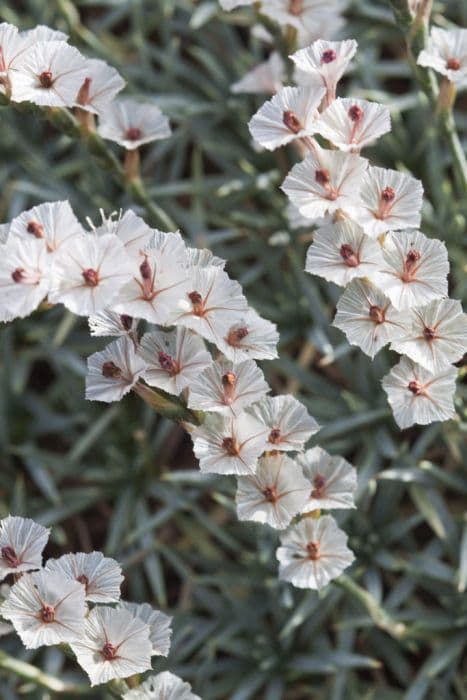
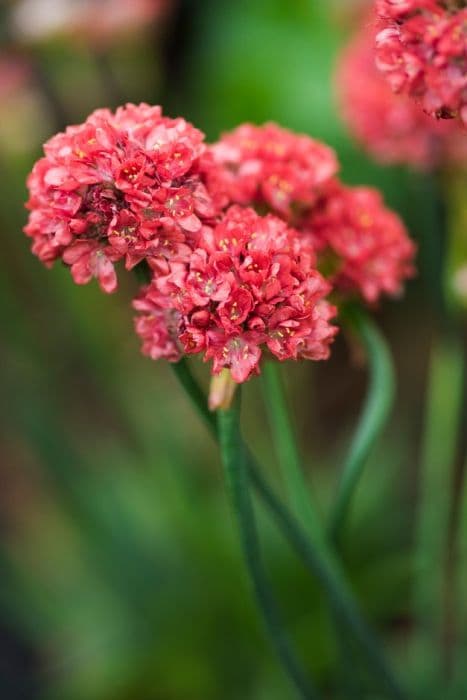
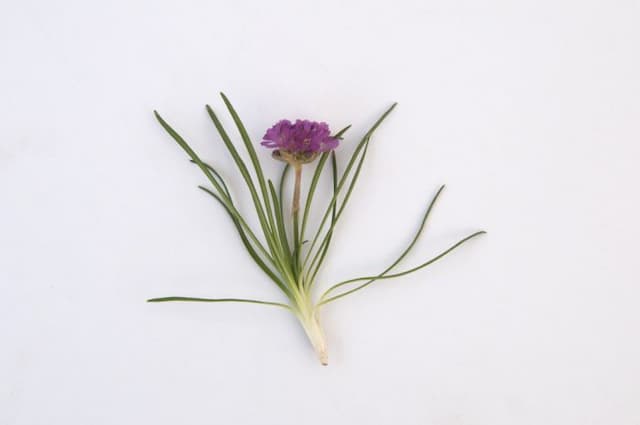


![Chinese plumbago [Forest Blue]](/_next/image?url=https%3A%2F%2Fplants-admin.emdemapps.com%2Fimages%2Fplants%2F%2Fimages%2F604b5c4db911f.png&w=640&q=75)


